- Home
- V. S. Naipaul
The Writer and the World Page 3
The Writer and the World Read online
Page 3
1962
Jamshed into Jimmy
“YOU’VE come to Calcutta at the wrong time,” the publisher said. “I very much fear that the dear old city is slipping into bourgeois respectability almost without a fight.”
“Didn’t they burn a tram the other day?” I asked.
“True. But that was the first tram for five years.”
And really I had expected more from Calcutta, the “nightmare experience” of Mr. Nehru, the “pestilential behemoth” of a recent, near-hysterical American writer, a city which, designed for two million people, today accommodates more than six million on its pavements and in its bastees, in conditions which unmanned the World Bank Mission of 1960 and sent it away to write what the Economic Weekly of Bombay described as a “strikingly human document.”
Like every newspaper-reader, I knew Calcutta as the city of tram-burners and students who regularly “clashed” with the police. A brief news item in The Times in 1954 had hinted memorably at its labour troubles: some disgruntled workers had tossed their manager into the furnace. And during my time in India I had been following the doings of its Congress-controlled Corporation, which, from the progressive nationalist citadel of the twenties, has decayed into what students of Indian affairs consider the most openly corrupt of India’s multitudinous corrupt public bodies: half the Corporation’s five hundred and fifty vehicles disabled, many of them stripped of saleable parts, repair mechanics hampered, accounts four years in arrears, every obstacle put in the way of “interference” by State Government, New Delhi and a despairing Ford Foundation.
At every level I found that Calcutta enjoyed a fabulous reputation. The Bengali was insufferably arrogant (“The pan-seller doesn’t so much as look at you if you don’t talk to him in Bengali”); the Bengali was lazy; the pavements were dyed red with betel-juice and the main park was littered with used sanitary towels (“very untidy people,” had been the comment of the South Indian novelist). And even in Bombay, the seat of gastro-enteritis, they spoke of Calcutta’s inadequate (thirteen out of twenty-two Corporation tubewells not working) and tainted water supply with terror.
I had therefore expected much. And Howrah station was promising. The railway officials were more than usually non-committal and lethargic; the cigarette-seller didn’t look at me; and in the station restaurant a smiling waiter drew my attention to a partly depilated rat that was wandering languidly about the tiled floor. But nothing had prepared me for the red-brick city on the other bank of the river which, if one could ignore the crowds, the stalls, the rickshaw-pullers and the squatting pissers, suggested, not a tropical or Eastern city, but central Birmingham. Nothing had prepared me for the Maidan, tree-dotted, now in the early evening blurred with mist and suggesting Hyde Park, with Chowringhee as a brighter Oxford Street. And nothing had prepared me for the sight of General Cariappa in the Maidan, dark-suited, English-erect, addressing a small relaxed crowd on the Chinese invasion in Sandhurst-accented Hindustani, while the trams, battleship-grey, with wedge-shaped snouts, nosed through the traffic at a steady eight miles an hour, the celebrated Calcutta tram, ponderous and vulnerable, bulging at entrances and exits with white-clad office workers, the neon lights beyond the Maidan gay in the mist: the invitations to espresso bars, cabarets, air travel. Here, unexpectedly and for the first time in India, one was in the midst of the big city, the recognizable metropolis, with street names—Elgin, Allenby, Park, Lindsay—that seemed oddly at variance with the brisk crowds, incongruity that deepened as the mist thickened to smog and as, travelling out to the suburbs, one saw the factory chimneys smoking among the palm trees.
And where in that bright heart, forgetting the pissers, were the piles of filth and refuse I had been told about, and the sanitary towels? In fact, as the publisher said, I had come to Calcutta at the wrong time. The city had recently been subjected to a brief and frenzied clean-up by the “volunteers” of the new Chief Minister of Bengal; it had been hoped that this would fill the Corporation’s professionals with “enthusiasm.” An “Operation Bull” had sought to clear the main streets of bulls which the devout Hindu releases into central Calcutta to service the holy cow. The idea was that the cows would follow the bulls. As it turned out, the cows had stayed; the bulls were returning. And no inhabitant of Calcutta doubted that with the withdrawal of the volunteers, and with so many things in India suspended because of the Emergency—suspension and prohibition being the administration’s current substitute for action—the filth too would return. But for the moment some of the unfamiliar gloss remained.
All the four main cities in India were developed by the British, but none has so British a stamp as Calcutta. Lutyens’s New Delhi is a disaster, a mock-imperial joke, neither British nor Indian, a city built for parades rather than people, and today given a correctly grotesque scale by the noisy little scooter-rickshaws that scurry about its long avenues and endless roundabouts. Madras, though possessing in Fort St. George one of the finest complexes of eighteenth-century British architecture outside Britain, is elsewhere lazily colonial. Bombay owes much to its Parsi community, enterprising, civic-minded, culturally ambiguous; the hysterical American already quoted speaks of Bombay’s “bandbox architecture,” and indeed this city, the best-run in India, is cosmopolitan to the point of characterlessness. Calcutta alone appears to have been created in the image of England, the British here falling, unusually, into the imperialist practice of the French and the Portuguese. And what has resulted in Calcutta is a grandeur more rooted than that of New Delhi: “the city of palaces” they called Calcutta, the palaces, Indian or British, built in a style which might best be described as Calcutta Corinthian: Calcutta, for long the capital of British India, the second city of the British Empire.
In India the confrontation of East and West was nowhere more violent than in Calcutta, and two buildings, both now regarded as monuments, speak of this violence: the Mullick Palace and the Victoria Memorial. Decaying now, with servants cooking in the marble galleries, the Mullick Palace still looks like a film set. It is dominated by tall Corinthian columns; Italian fountains play in the grounds; its excessively chandeliered marble rooms are crowded out with the clutter of a hundred nineteenth-century European antique shops, this dusty plaster cast of a Greek nymph hiding that faded, unmemorable painting of red-coated soldiers repulsing some native attack. In the courtyard four marble figures represent the major continents; and on the lower floor the monumental statue of a youthful Queen Victoria makes a big room small. None of the dusty treasures of the Mullick Palace is Indian, save perhaps for a portrait of the collector: the original Bengali babu, anxious to prove to the supercilious European his appreciation of European culture. And on the Maidan stands the Victoria Memorial, Curzon’s answer to the Taj Mahal, as studiedly derivative as the Mullick Palace, here recalling the Taj, there recalling the Salute. “Passing through the Queen’s vestibule into the Queen’s Hall under the dome,” says Murray’s Handbook, which characteristically gives twice as much space to this Raj Taj as to the Kailasa Temple at Ellora,
one sees the dignified statue of Queen Victoria at the age when she ascended the throne (the work of Sir Thomas Brock RA); this gives the keynote to the whole edifice.
Yet out of this confrontation there emerged something new in India, an explosive mixture of East and West, a unique culture which, however despised by the non-Calcutta Bengali as jumped-up and camp-following, gave Indian nationalism many of its prophets and heroes. The Bengali will tell you that British officials were urged to treat the South Indian as a slave, the Punjabi as a friend, and the Bengali as an enemy. But when the Bengali tells you this he is speaking as of lost glories, for today, with Independence and the partition of Bengal (in Calcutta the words are synonymous), the heart has gone out of Calcutta. It is a city without a hinterland, a dying city. Even the Hooghly is silting up, and everyone agrees that Calcutta has ceased to grow economically, however much it might spread physically. Though there are endearing vestiges of the Mullick Palace ment
ality in, say, the literary criticism of Professor Sa-dhan Kumar Ghosh (compassionately dealt with in the New Statesman by Malcolm Muggeridge), Calcutta is exhausted, its people withdrawn. It has Satyajit Ray, the film director; it has in Sunil Janah a photographer of world stature; Bengali typography, nervously elegant, is perhaps the best in India. But the glory lies in the past, in Tagore, in Bankim Chandra Chatterji, in the terrorists, in Subhas Chandra Bose. (1962 was a good year for the Bose legend: one libel action brought by a member of the family against an Englishwoman, and another reported reappearance, this time as a sadhu in the Himalayas.)
Calcutta remains what it always has been through growth, creative disorder, quiescence. It is still, despite the strong challenge of Bombay, India’s principal commercial city, and the element of Calcutta culture which might be said to be dominant is that represented by the business buildings of Dalhousie Square and the squat business houses of Imperial Tobacco and Metal Box on Chowringhee. There in air-conditioned offices may be found the young Indian business executives, the box-wallahs, the new Indian élite. A generation ago such positions would not have been acceptable to any Indian of birth; and he almost certainly would not have been accepted. But the Indian genius for compromise is no less than that of the British. The box-wallah culture of Calcutta is of a peculiar richness, and if it has not yet been explored by Indian writers this is because they have been too busy plagiarizing, or writing harrowing stories about young girls drifting into prostitution to pay the family’s medical bills and stories about young girls, poor or pretty, who inexplicably die. This culture, though of Calcutta, is not necessarily Bengali. Commerce is controlled by the British and increasingly since Independence by the Marwaris—it is almost with pride that the Bengali tells you there is no Bengali businessman worth the name. The Marwaris are Indian but are spoken of throughout India as a community even more alien than the British: the feeling against them in Calcutta is something you can cut with a knife. No one of standing wishes to be directly employed by the Marwaris. The conditions are not as good as those offered by the British who are reputable; in the public mind Marwari businessmen are associated with black-marketing and speculation. No one who works for the Marwaris can therefore properly be considered a box-wallah—your true box-wallah works only for the best British firms. (“Tell me,” they were asked at Imperial Tobacco, “was that very large painting of the Queen put up especially for the Queen’s visit?” “No,” was the box-wallah reply. “It is always there.”)
No one in Calcutta is sure of the origin of the word box-wallah. It has been suggested that it comes from the street pedlar’s box; but in Calcutta the word has too grand and restricted a significance, and it seems to me more likely to have been derived from the Anglo-Indian office-box of which Kipling speaks so feelingly in Something of Myself. Perhaps the office-box, like the solar topee (still worn with mournful defiance by those ICS officers who despair of further promotion), was a symbol of authority; and though the symbols have changed, the authority has been transferred and persists.
The Calcutta box-wallah comes of a good family, ICS, Army or big business; he might even have princely connections. He has been educated at an Indian or English public school and at one of the two English universities, whose accent, through all the encircling hazards of Indian intonation, he rigidly maintains. When he joins his firm his first name is changed. The Indian name of Anand, for example, might become Andy; Dhandeva will become Danny, Firdaus Freddy, Jamshed Jimmy. Where the Indian name cannot be adapted, the box-wallah will most usually be known as Bunty. It is a condition of Bunty’s employment that he play golf; and on every golf course he can be seen with an equally unhappy Andy, both enduring the London-prescribed mixture of business and pleasure.
Bunty will of course marry well, and he knows it will be counted in his favour if he contracts a mixed marriage; if, say, as a Punjabi Hindu he marries a Bengali Muslim or a Bombay Parsi. Bunty and his wife will live in one of the company’s luxury flats; they will be called Daddy and Mummy by their two English-speaking children. Their furnishings will show a happy blend of East and West (Indian ceramics are just coming in). So too will their food (Indian lunch followed by Western-style dinner), their books, their records (difficult classical Indian, European chamber music) and their pictures (North Indian miniatures, Ganymed reproductions of Van Gogh).
Freed of one set of caste rules, Bunty and his wife will adopt another. If his office has soft furnishings he will know how to keep his distance from Andy, whose furnishings are hard; and to introduce Andy, who shares an air-conditioned office with Freddy, into the home of Bunty, who has an office to himself, is to commit a blunder. His new caste imposes new rituals on Bunty. Every Friday he will have lunch at Firpo’s on Chowringhee, and the afternoon-long jollity will mark the end of the week’s work. In the days of the British this Friday lunch at Firpo’s celebrated the departure of the mail-boat for England. Such letters as Bunty sends to England go now by air, but Bunty is conscious of tradition.
It is impossible to write of Bunty without making him appear ridiculous. But Bunty is the first slanderer of his group; and enough has been said to show how admirable, in the Indian context, he is. Where physical effort is regarded as a degradation and thick layers of fat are still to many the marks of prosperity, Bunty plays golf and swims. Where elections are won on communal campaigns, Bunty marries out of his community. Bunty is intelligent and well-read; like most educated Indians, he talks well; though he has abandoned the social obligations of the Indian joint family, he is generous and hospitable; he supports the arts. Not least of his virtues is that he keeps a spotless lavatory. East and West blend easily in him. For him, who has grown up in an independent India, Westernization is not the issue it was to his grandfather and even his father. He carries no chip on his shoulder; he does not feel the need to talk to the visitor about India’s ancient culture.
Occasionally, very occasionally, the calm is disturbed. “These damned English!” Bunty exclaims. “When are they going to learn that 1947 really happened?” The words are like an echo from the Mullick Palace. But it is a passing mood. Soon Bunty will be out on the golf course with Andy. And golf is a game they both now love.
1963
A Second Visit
I
Tragedy: The Missing Sense
THE RAJA RECLINES below a broken chandelier in a dark narrow room right at the back of the palace. The room is in the third courtyard, the only part of the palace that still works. The raja’s armchair belongs to an extensive “sofa-set”—English suburban, 1930—distributed down the length of the room; the magenta upholstery is grimy. A rag-carpet completely covers the floor. It has been cut out from a more enormous piece, and is folded under where it doesn’t fit. It is in a violent pattern of yellow and green that camouflages the million flies that buzz in and out of the rags. A photograph of the raja’s father hangs forward from the wall; flat against the wall are a photograph of a family group, a hunting print in a rustic frame, and, at the top, in the yellowing colours of an unsuccessful reproduction process, a row of misty European landscapes.
Against this the raja sits, young, plump, cool in loose white cotton, and listens without expression to his last courtier, who sits at his feet on the rag-carpet and, holding a creased typewritten memorandum of many pages, outlines once again the complications of the inter-family litigation about the property that remains. The courtier is gaunt, his bony face finer than his master’s; his clothes are dingier. He is a B.A.—the achievement is still fresh in his mind. He entered the service of the raja’s family nearly fifty years ago, and now—his own son is dead—he has nowhere else to go.
Lunch is ordered for the visitors. The raja’s younger brother, lean, elegant in movement—he is an attractive badminton player—offers to show the sights. The palace is in the nondescript Lucknow style, and not old. Most of what we see was built in the 1920s, at a cost of half a million pounds. The family’s revenue then was £60,000. An oval-shaped garden in the fore
court, overgrown. Tall carved wooden doors from a provincial exhibition of 1911 (the Raj then in its glory, with at least two society magazines in Calcutta, the capital). The clock-tower courtyard, with crude roundels down the archway: an English couple between the Hindu and the Muslim: he in broad-lapelled jacket and sun-helmet, she in the loose lines of the 1920s. Beyond, the apartments, miniature palaces, of the former raja’s wives: the source of the present litigation.
The raja’s younger brother says there are six hundred rooms in all. The statement is disturbing. It is surely an exaggeration. Exaggeration does not belong to tragedy; it destroys the mood. And once, just twenty-five, thirty years ago, five hundred servants looked after the twenty-five members of the family. Round figures again, no doubt. But the palace had its own generating plant, stables for horses and elephants, its own zoo, its own reservoir. All this is shown from the clock-tower, the English machinery broken, the plaster broken. But the view from the clock-tower also shows no other building of consequence. It shows only the grass roofs of the bazaar settlement just outside the palace gates, and the flat scorched fields.
The eagerness of the raja’s brother denies sadness. And there can be no sadness. Because there was no true grandeur. There was only excess and exaggeration, dying at the stroke of the legislator’s pen that abolished large estates. The palace rose out of this dust; it expressed this dust, nothing more; it is returning to dust again; and the cycle had been unfruitful (the sofa-set, the landscape prints). Peasant, briefly prodigal, is turning to peasant again, as the kitchens of the third courtyard show. There is no vacuum; litigation totally engages the calm mind. There is no tragedy. There is, as perhaps there always has been, drabness. In this plain landscape wealth itself had been just another simplicity, an event, like decay.

 The Masque of Africa: Glimpses of African Belief
The Masque of Africa: Glimpses of African Belief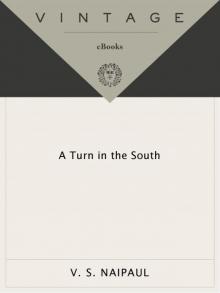 A Turn in the South
A Turn in the South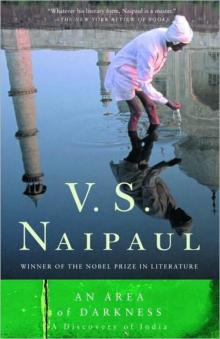 An Area of Darkness
An Area of Darkness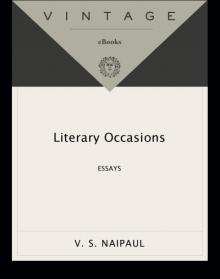 Literary Occasions: Essays
Literary Occasions: Essays A Way in the World
A Way in the World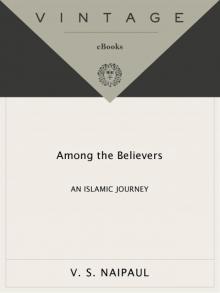 Among the Believers: An Islamic Journey
Among the Believers: An Islamic Journey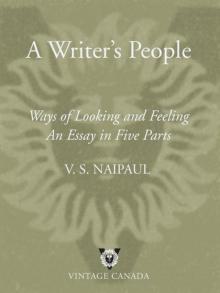 A Writer's People: Ways of Looking and Feeling
A Writer's People: Ways of Looking and Feeling The Mimic Men: A Novel
The Mimic Men: A Novel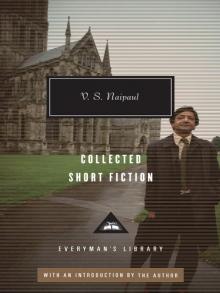 Collected Short Fiction
Collected Short Fiction India: A Million Mutinies Now
India: A Million Mutinies Now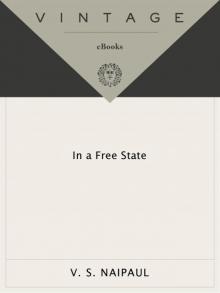 In a Free State
In a Free State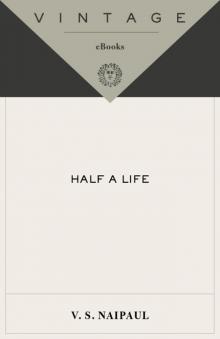 Half a Life
Half a Life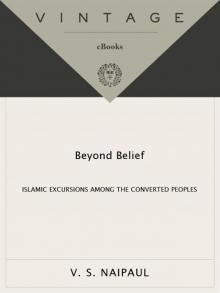 Beyond Belief: Islamic Excursions Among the Converted Peoples
Beyond Belief: Islamic Excursions Among the Converted Peoples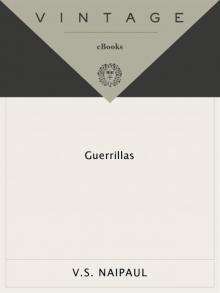 Guerrillas
Guerrillas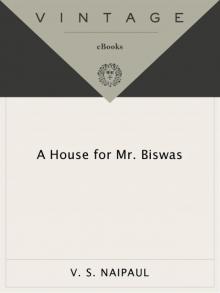 A House for Mr. Biswas
A House for Mr. Biswas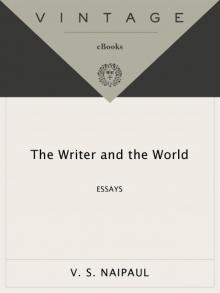 The Writer and the World: Essays
The Writer and the World: Essays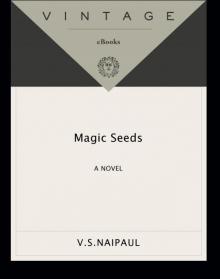 Magic Seeds
Magic Seeds The Mystic Masseur
The Mystic Masseur Miguel Street
Miguel Street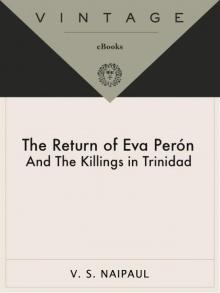 The Return of Eva Perón, With the Killings in Trinidad
The Return of Eva Perón, With the Killings in Trinidad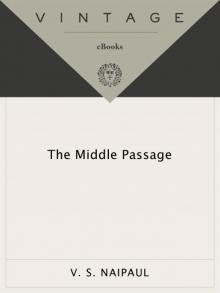 The Middle Passage
The Middle Passage A Bend in the River
A Bend in the River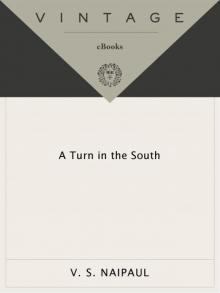 A Turn in the South (Vintage International)
A Turn in the South (Vintage International)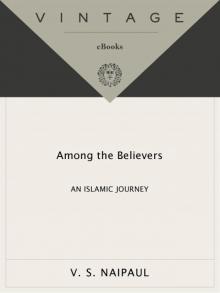 Among the Believers
Among the Believers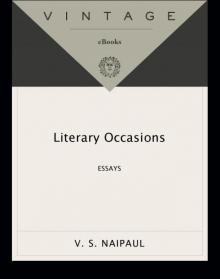 Literary Occasions
Literary Occasions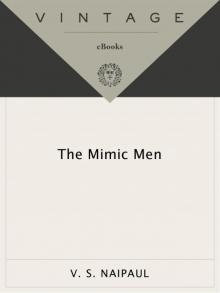 The Mimic Men
The Mimic Men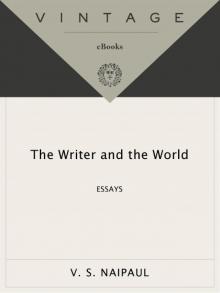 The Writer and the World
The Writer and the World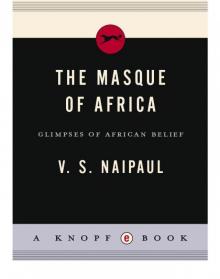 The Masque of Africa
The Masque of Africa